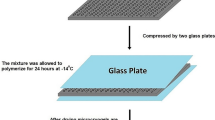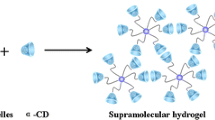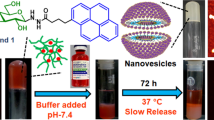Abstract
In this work, microscale poly-2-hydroxyethyl methacrylate [p(HEMA)]-based cryogels were fabricated as a drug delivery material using molecular imprinting technology for controlled release of mitomycin C (MMC) as an anti-cancer drug. MMC imprinted pHEMA-based micro cryogels (pMIPs) were prepared according to free-radical polymerization by using N-methacryloyl-(l)-histidine methyl ester (MAH) as an amino-acid-based polymerizable functional monomer using a micro stencil array chip with microwells of 200 μm diameter and 500 μm thickness. Following that, scanning electron microscope, swelling test, and Fourier Transform Infrared Spectroscopy were used for the characterization studies of pMIPs. After the characterization studies, MMC release performance of pMIPs was investigated towards the different pH values and various MMC concentrations in the aqueous solutions. The in vitro cytotoxicity studies of the pMIPs and the non-imprinted pHEMA based micro cryogels (pNIPs) were examined using L929 cell line. According to the experimental findings, the incorporation of MAH monomer could increase the release performance of pMIPs and the release of MMC from the pMIPs was non-Fickian in the aqueous solution. pMIPs did not show any noticeable cytotoxicity and could be potentially used as a new drug carrier for MMC release.






Similar content being viewed by others
References
Hassanpour SH, Dehghani M (2017) Review of cancer from perspective of molecular. J Cancer Res Pract 4:127–129
Chowdhury S, Yusof F, Salim WW, Sulaiman N, Faruck MO (2016) An overview of drug delivery vehicles for cancer treatment: nanocarriers and nanoparticles including photovoltaic nanoparticles. J Photochem Photobiol B Biol 164:151–159
Alam A, Farooq U, Singh R, Dubey VP, Kumar S (2018) Chemotherapy treatment and strategy schemes: a review. Open Acc J of Toxicol 2(5):555600
Knoepfler PS (2009) Deconstructing stem cell tumorigenicity: a roadmap to safe regenerative medicine. Stem Cell 27(5):1050–1056
Verweij J, Pinedo HM (1990) Mitomycin C mechanism of action, usefulness and limitations. AntiCancer Drug 1:1–15
Marquez EA, Katsanos A, Kozobolis VP, Konstas AGP, Teus MA (2019) A critical overview of the biological effects of mitomycin C application on the cornea following refractive surgery. Adv Ther 36:786–797
Yang H, Wang M, Huang Y, Qiao Q, Zhao C, Zhao M (2019) In vitro and in vivo evaluation of a novel mitomycin nanomicelle delivery system. RSC Adv 9:14708–14717
Kotmakchiev M, Kantarcı G, Cetintas V (2012) Cytotoxicity of a novel oil/water microemulsion system loaded with mitomycin C in in vitro lung cancer models. Drug Dev Res 73(4):185–195
Lulinski P (2017) Molecularly imprinted polymers based drug delivery devices: a way to application in modern pharmacotherapy, a review. Mater Sci Eng C 76:1344–1353
Bakhshpour M, Yavuz H, Denizli A (2018) Controlled release of mitomycin C from PHEMAH-Cu (II) cryogel membranes. Artif Cell Nanomed Biotechnol 46:946–954
Öncel P, Çetin K, Topçu AA, Yavuz H, Denizli A (2017) Molecularly imprinted cryogel membranes for mitomycin C delivery. J Biomater Sci Polym Ed 28(6):519–531
Sanadgol N, Wackerling J (2020) Developments of smart drug-delivery systems based on magnetic molecularly imprinted polymers for targeted cancer therapy: a short review. Pharmaceutics 12:831
Juric D, Rohner NA, von Recum HA (2019) Molecular imprinting of cyclodextrin supramolecular hydrogels improves drug loading and delivery. Macromol Biosc 19:1–9
Bai J, Zhang Y, Chen L, Yan H, Zang C, Liu L, Xu X (2018) Synthesis and characterization of paclitaxel-imprinted microparticles for T controlled release of an anticancer drug. Mater Sci Eng C 92:338–348
Bakhspour M, Topcu AA, Bereli N, Alkan H, Denizli A (2020) Poly(hydroxyethyl methacrylate) immunoaffinity cryogel column for the purification of human immunoglobulin M. Gels 6(4):1–13
Özgür E, Bereli N, Türkmen D, Ünal S, Denizli A (2011) PHEMA cryogel for in-vitro removal of anti-dsDNA antibodies from SLE plasma. Mater Sci Eng C 31:915–920
Saylan Y, Denizli A (2019) Supermacroporous composite cryogels in biomedical applications. Gels 5(2):20
Villard P (2019) Autoclavable and injectable cryogels for biomedical applications. Adv Healthcare Mater 8:1900679
Cetin K, Denizli A (2019) Immunoaffinity microcryogels for purification of transferrin. J Chromatogr B 1114–115:5–12
Bakhshpour M, Idil N, Perçin I, Denizli A (2019) Biomedical applications of polymeric cryogels. Appl Sci 9(3):553
Xing D, Liu W, Wang B, Li JJ, Zhao Y, Li H, Liu A, Du Y, Lin J (2020) Intra-articular injection of cell-laden 3D microcryogels empower low-dose cell therapy for osteoarthritis in a rat model. Cell Transpl 29:1–12
Fang YP, Hu PY, Huang YB (2018) Diminishing the side effect of mitomycin C by using pH-sensitive liposomes: in vitro characterization and in vivo pharmacokinetics. Drug Des Devel Ther 12:159–169
Underberg WJ, Lingeman H (1983) Aspects of the chemical stability of mitomycin and porfiromycin in acidic solution. J Pharm Sci 72(5):549–553
Attieh DM, Chaib H, Armutcu C, Uzun L, Elkak A, Denizli A (2013) Immunoglobulin G purification from bovine serum with pseudo-specific macroporous cryogels. Sep Purif Technol 118:816–822
Derazshamshir A, Baydemir G, Yılmaz F, Bereli N, Denizli A (2016) Preparation of cryogel columns for depletion of hemoglobin from human blood. Artif Cell Nanomed 44(3):792–799
Andac M, Tamahkar E, Denizli A (2021) Molecularly imprinted smart cryogels for selective nickel recognition in aqueous solutions. J Appl Polym Sci 138:e49746
Bajpai AK, Saini R (2005) Preparation and characterization of biocompatible spongy cryogels of poly (vinyl alcohol)–gelatin and study of water sorption behaviour. Poly Int 54:1233–1242
Chaturvedi A, Bajpai AK, Bajpai J, Singh SK (2016) Evaluation of poly (vinyl alcohol) based cryogel–zinc oxide nanocomposites for possible applications as wound dressing materials. Mater Sci Eng C 65:408–418
Higuchi T (1963) Theoretical analysis of rate of release of solid drugs dispersed in solid matrices. J Pharm Sci 52:1145–1149
Korsmeyer RW, Gurny R, Doelker E, Buri P, Peppas NA (1983) Mechanisms of solute release from porous ydrophilic polymers. Int J Pharm 15:25–35
Vergnaud JM (1993) Liquid transport-controlled release processes in polymeric materials: applications to oral dosage forms. Int J Pharm 90:89–94
Tamahkar E, Bakhshpour M, Denizli A (2019) Molecularly imprinted composite bacterial cellulose nanofibers for antibiotic release. J Biomater Sci Polym Ed 30(6):450–461
Zhu J, Yang F, He F, Tian X, Tang S, Chen X (2015) A tubular gelatin scaffold capable of the time-dependent controlled release of epidermal growth factor and mitomycin C. Colloids Surf B Biointerfaces 135:416–424
Kolawole OM, Lau WM, Khutoryanskiy VV (2019) Chitosan/β-glycerophosphate in situ gelling mucoadhesive systems for intravesical delivery of mitomycin-C. Int J Pharm X 1:100007
Sultana T, Van Hai H, Park M, Lee S, Lee B (2020) Controlled release of Mitomycin C from modified cellulose based thermo-gel prevents post-operative de Novo peritoneal adhesion. Carbohydr Polym 229:115552
Türkmen D, Bereli N, Çorman ME, Shaikh H, Akgöl S, Denizli A (2013) Molecular imprinted magnetic nanoparticles for controlled delivery of mitomycin C. Artif Cell Nanomed Biotechnol 42(5):316–322
Xi-xiao Y, Jan-hai C, Shi-ting L, Dan G, Xv-xin Z (2006) Polybutylcyanoacrylate nanoparticles as a carrier for mitomycin C in rabbits bearing VX2-liver tumor. Regul Toxicol Pharmacol 46(3):211–217
Hu B, Tu Y, Yan G, Zhuo R, Bottle SE, Wu Y, Fan C, Duan Y (2011) Polycarbonate microspheres containing mitomycin C and magnetic powders as potential hepatic carcinoma therapeutics. Colloids Surf B Biointerfaces 84(2):550–555
D’souza SL, Chettiar SS, Koduru JR, Kailasa SK (2018) Synthesis of fluorescent carbon dots using daucus carota subsp. sativus roots for mitomycin drug delivery. Optik 158:893–900
Wu M, Wang S, Wang Y, Zhang F, Shao T (2020) Targeted delivery of mitomycin C-loaded and LDL-conjugated mesoporous silica nanoparticles for inhibiting the proliferation of pterygium subconjunctival fibroblasts. Exp Eye Res 197:108124
Sun X, Sun P, Li B, Liu Y, Wang M, Suo N, Yang M, Zhang D, Jin X (2016) A new drug delivery system for mitomycin C to improve intravesical instillation. Mater Des 110:849–857
Acknowledgement
This study is a part of Soheil Zahibi’s Ph.D. thesis submitted to Hacettepe University, Chemistry Department, Science Instutite, Beytepe, Ankara, Turkey.
Author information
Authors and Affiliations
Corresponding author
Additional information
Publisher's Note
Springer Nature remains neutral with regard to jurisdictional claims in published maps and institutional affiliations.
Supplementary Information
Below is the link to the electronic supplementary material.
Rights and permissions
About this article
Cite this article
Zabihi, S., Bakhshpour, M., Çalışır, M. et al. Preparation of molecular imprinted injectable polymeric micro cryogels for control release of mitomycin C. Polym. Bull. 80, 3883–3895 (2023). https://doi.org/10.1007/s00289-022-04233-y
Received:
Revised:
Accepted:
Published:
Issue Date:
DOI: https://doi.org/10.1007/s00289-022-04233-y




